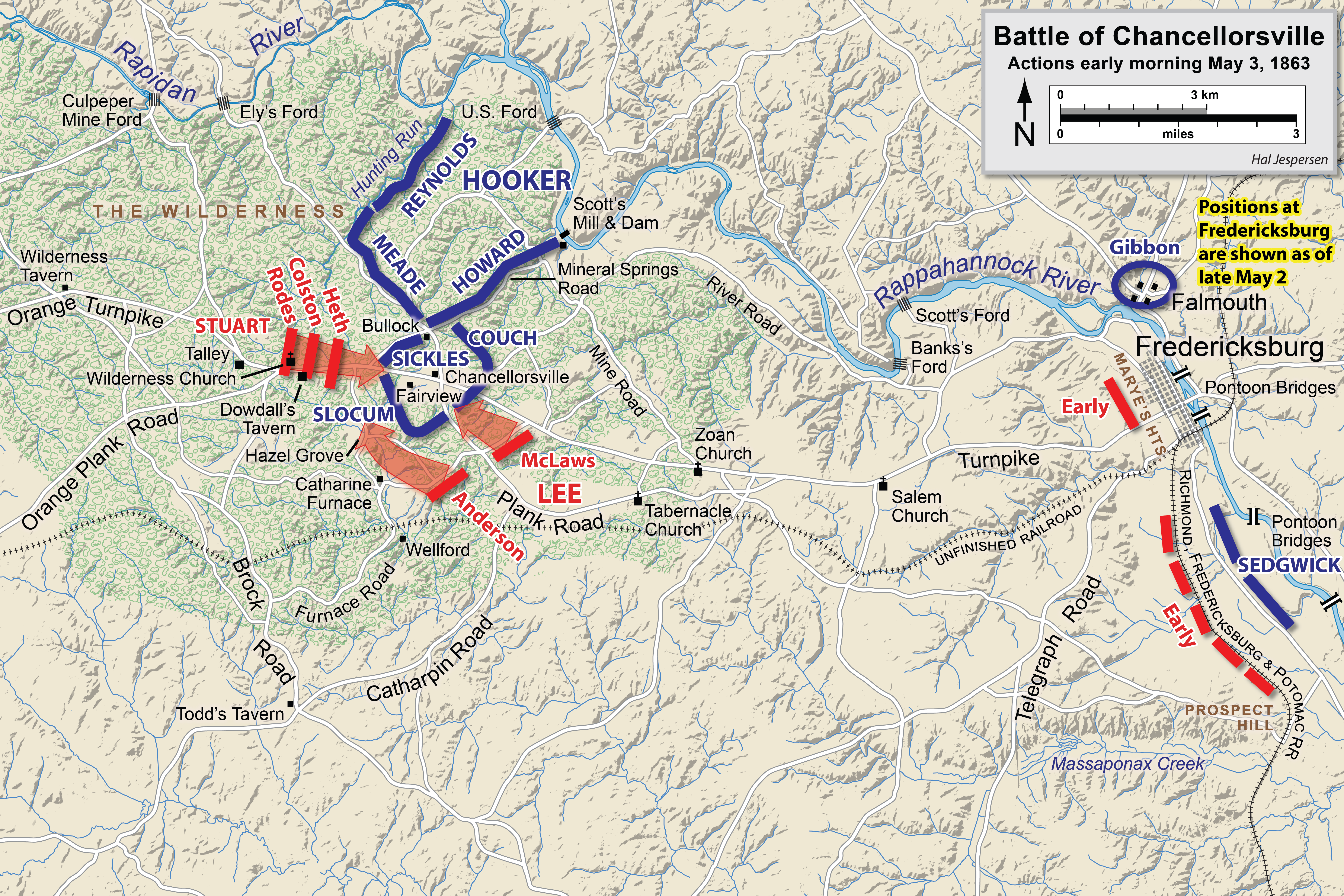See all posts on the Battle of Chancellorsville
 |
| Wounded Union soldiers |
Although Howard's XI Corps of the Union army had been destroyed on May 2, Hooker still had many more men than Lee for the fighting the next day. He also had the better position, with Sickles holding the high ground at Hazel Grove that separated Stuart and Lee. From there his line curved back like a horseshoe, with each side anchored on a river, the right on the Rapidan and the left on the Rappohannock. There would be no more flanking today.
But Hooker did not recognize the importance of the position he held. He ordered Sickles to abandon Hazel Grove and fall back to the Plank Road. Sickles protested, but Hooker believed that it had to be done to simply the defense. Once Sickles fell back, the Confederates occupied Hazel Grove. It proved not only an opportunity to reunite the Confederate army, but also the key to the entire battlefield. Confederate artillery commander Col. E. Porter Alexander had spotted the site during the night and was ready to occupy it as soon as Sickles fell back. Over the winter Alexander had reorganized the Confederate artillery into battalions, and this centralized system allowed guns to be brought up quickly to man the valuable position. The Confederate cannons placed at Hazel Grove soon opened on the Union artillery position at Fairview, 1200 yards distant. 30 cannons converged with 54 elsewhere on the line, creating a very destructive fire. Some have called it the Army of Northern Virginia's best artillery position in the war, and Hooker had given it up without a fight.
 |
| Confederates attack Hazel Grove |
Ol' Joe Hooker, won't you come out of The Wilderness? Come out of The Wilderness, come out of The Wilderness? Ol' Joe Hooker, won't you come out of The Wilderness? Bully boys, hey! Bully boys, ho!Finally the Federal lines broke under a charge by the last division, that of Rhodes, combined with the effects of the tremendous bombardment. The victorious Confederates plunged forward with shouts of "Remember Jackson!"
It was at this moment, in the height of the battle, that the most important casualty of that day of fighting occurred – Joe Hooker himself. The Chancellor house, for which the battle would be named, was being used as Hooker's headquarters as well as a field hospital. The Confederate artillery pieces began throwing their shells into the area to disrupt Union communications and supplies. Just after 9:00 Hooker was standing on the porch of a house when a solid Confederate cannonball struck the pillar on which he was leaning, knocking him to the ground and throwing splinters everywhere. His staff put him down on a blanket and gave him some brandy. Eventually he felt well enough to stand up. Just as he did that another ball flew into the area and struck the blanket on which he had just been lying, demonstrating that this was no place for the commander of the army. Riding off, Hooker soon sent a message to summon Darius Courch. He turned over the command, as he had been badly shaken by the shock. Hooker said, "Couch, I turn the command of the army over to you. You will withdraw it and place it in the position designated on this map."
But even as he turned over the command, he gave Couch orders which Couch disagreed with. The army's new commander wanted to try to continue to hold the ground they still had. But Hooker had made up his mind to abandon the field, and there was little anyone else could do about it.
 |
| Lee cheered by his men |
The scene can never be effaced from the minds of those that witnessed it. The troops were pressing forward with all the ardor and enthusiasm of combat. The white smoke of musketry fringed the front of battle, while the artillery on the hills in rear shook the earth with its thunder and filled the air with the wild shrieking of the shells that plunged into the masses of the retreating foe. To add greater horror and sublimity to the scene, the Chancellorsville House and the woods surrounding it were wrapped in flames. It was then that General Lee rode to the front of his advancing battalions. His presence was the signal for one of those uncontrollable bursts of enthusiasm which none can appreciate who has not witnessed them. The fierce soldiers, with their faces blackened with the smoke of battle, the wounded crawling with feeble limbs from the fury of the devouring flames, all seemed possessed with a common impulse. One long unbroken cheer, in which the feeble cry of those who lay helpless on the earth blended with the strong voices of those who still fought, rose high above the roar of battle and hailed the presence of a victorious chief. He sat in the full realization of all that soldiers dream of—triumph; and as I looked at him in the complete fruition of the success which his genius, courage, and confidence in his army had won, I thought that it must have been from some such scene that men in ancient days ascended to the dignity of gods.The Southerners continued to press forward, routing the in some places and almost catching Howard's XI Corps in the flank as they had done the day before.
 |
| Sedgwick breaks through on May 3rd |
 |
| Skeletons in the woods at Chancellorsville |


0 comments:
Post a Comment